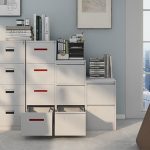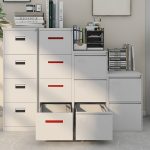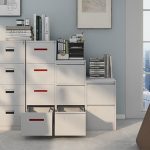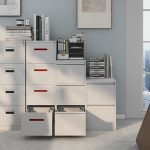Lateral file cabinets are an important tool for storing and managing documents. With its unique design and convenient use experience, it has become the first choice for many companies and personal offices. This article will take you to a deeper understanding of lateral file cabinets.
What is a lateral file cabinet?
The design of lateral file cabinets focuses more on the lateral utilization of space. The drawers are pulled out from the side, allowing lateral file access. They are available in various sizes and configurations, from two drawers to four drawers or more, to meet different storage needs.

Do lateral file cabinets hold more?
Yes. Lateral file cabinets are generally more spacious and can store more files than vertical file cabinets, especially when you have a high volume of paperwork or larger documents. They are also great for organizing files in a way that makes them easier to access at a glance.
Design features of lateral file cabinets
Lateral storage: The drawers are opened sideways, usually with a larger width, higher storage capacity, and easy access, suitable for long folders, file boxes, and other office supplies.
Multiple drawer design: Lateral file cabinets usually have two to five drawers, with deep drawer depth. Each drawer can accommodate a large number of files in a classified manner. The drawer is usually equipped with a hanging folder rod to facilitate the filing and retrieval of files.
Spacious and stable structure: Lateral file cabinets have a low center of gravity, good cabinet stability, and are not easy to tilt or collapse.
Advantages of lateral file cabinets
Space saving: Lateral file cabinets usually do not require much vertical space and are suitable for office environments with limited space.
Convenience and easy access: The lateral design makes the drawer opening wider, so users can see all files at a glance, find them quickly, and save time.
Easy to classify and manage files: The file cabinet has a large capacity and can accommodate a large number of files in categories. By labeling the drawers or using color distinction, you can find and file files more efficiently.
Good stability: Lateral file cabinets have a stronger load-bearing capacity and are suitable for storing heavier files or office materials.
Applicable scenarios for lateral file cabinets
Personal workstations
Small offices or home offices
Team collaboration spaces
Libraries or archives
Schools or educational institutions
Law or accounting firms
Medical facilities such as hospitals and clinics
Creative studios or design agencies

How to choose a suitable lateral file cabinet?
When choosing a lateral file cabinet, you need to consider the following factors:
Size and space: Consider the size of the cabinet and the adaptability of the space, ensure that the office space can accommodate the volume of the file cabinet, and consider the space requirements for the drawers to be fully opened.
Material and quality: File cabinets are usually made of steel, wood or composite materials. Steel file cabinets are sturdy and durable, suitable for long-term use; wooden file cabinets have higher aesthetics and texture; composite file cabinets are cheaper. Choose a file cabinet of the right material according to your needs.
Storage requirements: Determine the size and partition design of the file cabinet according to the type and quantity of files to be stored. If you store a large number of files or heavy items, choose a file cabinet with a stronger load-bearing capacity.
Locking function: Consider the type of lock (such as password lock, fingerprint lock, etc.) and security to ensure that important files are not accessed by unauthorized personnel.
Design: Consider the coordination of the file cabinet with the surrounding environment, including color, material and style. Choose a file cabinet that matches the environment to enhance the overall aesthetics.
Additional functions: Choose a file cabinet with additional functions as needed, such as adjustable shelves, hidden drawers, etc.
Price and Budget: The price of file cabinets varies depending on factors such as brand, material, size and function. Before purchasing, set a reasonable budget range and choose the most cost-effective product within this range.
Care and maintenance of lateral file cabinets
You can regularly wipe the surface of the file cabinet with a soft damp cloth to remove dust and stains. Avoid using detergents containing chemical ingredients to avoid damage to the cabinet.
The file cabinet should be placed in a dry, well-ventilated location and should not be near water sources or wet areas.
Reasonably distribute the weight and avoid overloading to ensure its structural safety.
Push and pull gently when opening and closing the cabinet doors and drawers; avoid contact with hard objects to prevent scratches or deformation.
You can regularly lubricate the sliding mechanism to ensure its smooth operation.
Regularly check the connection parts and screws of the filing cabinet for looseness or damage, and tighten or replace them in time if necessary.
Lateral file cabinets are an ideal solution for optimizing office storage. By understanding its unique features and advantages, you can choose the most suitable lateral filing cabinet according to your needs and provide a long-term solution for office organization and storage.





